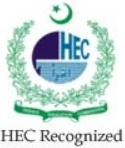Unearthing of the Time of Emplacement of the Sillai Patti Carbonatite, Khyber Pakhtunkhwa, Pakistan: Constraints from 206Pb/238U Zircon Dating
DOI:
https://doi.org/10.63147/krjs.v3i1.19Keywords:
206Pb-238U dating; Sillai Patti carbonatite; Emplacement Time, Waziristan carbonatiteAbstract
The Sillai Patti carbonatite complex constitutes the second largest carbonatite complex of the Peshawar Plain Alkaline Igneous Province of northern Pakistan. It is located about 20 km west of Malakand, near Sillai Patti village. Here, the carbonatite occurs as intrusion along a fault in the form of a sheet striking in the NNE-SSW direction and dipping towards south. The carbonatite body is about 12 km in length and 2-20 m in thickness. The carbonatite sheet is emplaced either within the metasediments or along the faulted contact of metasediments and granite gneiss. Petrogenic, geochronological and tectonic history of this complex has been poorly understood so far. Therefore, 206Pb-238U dating study on zircon samples was conducted on the complex for the first time for resolving these critical issues.
A 206Pb - 238U age of 85.7 ± 0.9 Ma was obtained on zircon crystals from the carbonatite samples of the complex by using Laser Ablation Inductively Coupled Plasma Mass Spectrometry (LA-ICP-MS). This newly determined high temperature age of 85.7 ± 0.9 Ma is substantially higher than the low temperature K-Ar Biotite age of 31 ± 2 Ma of Le Bas et al. (1987), Fission Track Zircon age of 32.1 ± 1.9 Ma of Qureshi et.al. (1991) and Fission Track Apatite age of 29.40 ± 1.49 Ma of Khattak et al. (2012). This age of 85.7 ± 0.9 Ma is similar with the Ar-Ar age of 80 Ma on Phlogopite from a group 1 carbonatite of the Waziristan Ophiolite Complex (WOC) of Badshah et al. (2003), found at the Pakistan-Afghanistan border, about 244 Km SW of Peshawar in Waziristan Agency. Close resemblance of the 206Pb-238U age of zircon from the Sillai Patti carbonatite with the Ar-Ar age on phlogopite from the carbonatites intruding the WOC clearly indicates that carbonatite and alkaline magmatism may have taken place on a much wider range extending from the Silla Patti area in the north up to Waziristan Agency near Pakistan Afghanistan border in the west of Bannu District during the Late Cretaceous, when the leading northern and western margins of the Indian plate were obducted by the ophiolite complexes.
Close resemblance of the fission-track and K-Ar ages of the Sillai Patti carbonatite with the fission-track and K-Ar ages from the neighboring carbonatite complexes of the alkaline belt of northern Pakistan suggests rapid uplift of the Sillai Patti carbonatite complex to higher crustal level during Oligocene time and subsequent extremely fast cooling to near ambient temperatures (< 60°C) required for the complete retention of fission tracks in apatite.
Downloads
Published
Issue
Section
License
Copyright (c) 2024 Nimat Ullah Khattak

This work is licensed under a Creative Commons Attribution-NonCommercial 4.0 International License.
This work is licensed under CC BY-NC 4.0











